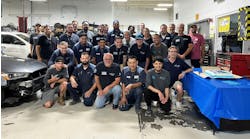S10 No Start
Dear RoyThe vehicle is a 1985 Chevrolet S-10 pickup with a 2.8L V6 engine and 700R4 automatic transmission (VIN LGCCS14B2F2246683).
The problem is that the truck won't start. We have replaced the plugs, wires, distributor cap, rotor, ignition module, and the carburetor base gasket. We have checked timing, compression, spark and fuel, and though the engine cranks just fine, it still won't start. Please help.
John Harrington
TJ's Auto World, Manning, SC
Dear Mr. Harrington.
Every gasoline engine requires four things to start and run: air, fuel, spark and compression. The air/fuel mixture has to be within a certain range to ignite, and the spark has to occur at precisely the right instant for the engine to start easily, idle smoothly and perform properly. If any of these four basic ingredients is lacking, the engine may fail to start.
From your message, I am going to assume that you have a good hot spark and the engine is mechanically sound with good compression. I will also assume that the carburetor is getting plenty of fuel/air and that the ignition is timed correctly.
Now, at this point it appears that this engine should run. However there are a couple of things we neglected to check. How about the fuel quality? What's in that tank? We can't burn water or contaminated liquids.
Also, an engine has to breathe. What goes in must find a way out. You can't burn inert gases in that combustion chamber. Try removing both rear spark plugs and attempt to start the engine. If the engine starts or makes an attempt to start, you have a plugged exhaust system.
The Pinging Suburban
Dear Roy,The vehicle is a 1999 Chevrolet Suburban with a 5.7L Vortec engine, VIN 3GNFK16R2XG104633. This truck has a very intermittent but predictable problem.
On long slow grades under light engine load, it will develop a spark knock, which will turn into a miss that eventually becomes severe enough to flash the CEL and set a code P0304 every time. I will have to back off of the gas until it improves enough to go on. I can duplicate this problem if given the right road.
All of the obvious has been done: intake gaskets were replaced, cam retard has been set to zero and the fuel pump has been replaced. I have road-tested it with the EGR functioning normally and disconnected. Nothing has changed. The freeze frame shows nothing out of the ordinary; fuel trims are always positive but not severe, only +6 to 9 percent. I also have checked exhaust backpressure, and it is less than 1 psi.
My next thought was to replace the #4 fuel poppet but was advised otherwise by my AAA tech representative until I checked to see if there was a FLASH program update available to help this. I have noticed that using premium fuel seems to alleviate this problem, but that may be a coincidence.
I hope you have some thoughts. Thanks in advance.
Dwayne Juelfs
Genuine Automotive, Alorton, IL
Dear Mr. Juelfs,
If premium fuel alleviates the condition, I would suspect carbon buildup, lack of EGR flow or most likely lean operation. Does the engine stall when you open the EGR at idle?
You state that fuel trim is approximately plus 6 to 9 percent. Is this short-term or long-term? Are both banks equal? What do the oxygen sensors tell us? What is the fuel pressure?
These engines require an absolute minimum fuel pressure of 55 psi when running. The poppet valves for these injectors are notorious for sticking and clogging. Have these been cleaned and checked?
Another area that can create a lean condition is water in the fuel. GM has issued a TSB #00-06-04-024 concerning water entering through the evaporative canister vent solenoid. A new vent hose, valve and solenoid have been developed to correct this condition. The part number is 15759042.
Code 66
Dear Roy,I have been troubleshooting and repairing automobiles now for 25 years, and I have been a subscriber of Motor Age ever since I can remember. I read your articles about how techs get stumped, and I really feel for them. I don't know how many times I've taken a stack of manuals home at night to figure out a problem I've had that day. Now I have one that's got me stumped.
One of my best customers has a 1992 Buick Regal GS with a 3800, and I have been fighting an A/C problem on this car for two years. This system uses the ECM to control the compressor. The A/C request signal comes from the HVAC controller through the high- and low-pressure switches to pin D20 of the ECM, which will then use pin A7 to operate the compressor clutch relay.
Like most GM systems of this vintage, the ECM cycles the compressor according to the low pressure switch. This car will idle with no pressure problems at all. But at about 2,000 rpm, the pressure starts to drop, and the compressor will start cycling at about 22 psi. After three cycles, the ECM sets a Code 66: "low A/C pressure." It will not again turn on the relay without clearing the code.
To my understanding, this is a safeguard in the system, so my first thought was a faulty expansion valve. I have tried every one of them on the market for this car, including a variable valve, with no success. I have flushed this system several times and can't find any restrictions.
The condenser was replaced along with a new accumulator when the car was changed to R134a. I tried an adjustable low-pressure switch, but if I lower the cycle pressure, it will freeze up the return line. In other A/C systems, this would just cycle the compressor and you would probably never know there was a problem. But after three times, Code 66 raises its ugly head again.
The air is cold, and there's no leak in the system. I called the local dealer, but no one there has worked on a car this old and they have no info for any ECM updates. Can you give me an answer?
Thank You,
Mike Poston, owner
R and M Auto Repair
Dear Mr. Poston
Yes, these systems were unique in that the ECM assumes the system is low on refrigerant if it sees the compressor cycling more rapidly than normal. When this occurs, Code 66 will set and the ECM will not provide a ground to the compressor relay. Normally checking the cycling switch and charging the system can repair this.
However I am aware of the condition you describe whenever these systems are converted to R134a. One technician explained to me that he had corrected the condition by installing a Ford orifice tube (blue) in place of the original. Another's fix was to install an additional relay to activate the compressor relay. This was accomplished by teeing into Circuit 67 for the low amperage relay coil; add two grounds and Circuit 366 to the relay output terminal. This will still allow a request input for idle and load but will prevent compressor cut-off at full throttle.
Good luck, and let us know how you made out. If any of our readers have other suggestions on how to solve this problem, please forward them to me through the "contact us" link on the Motor Age Web site www.motorage.com



